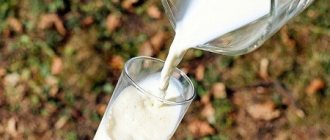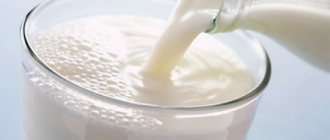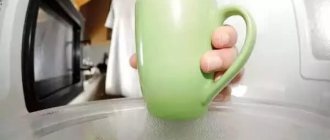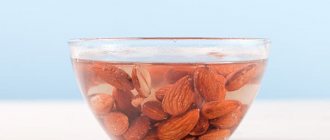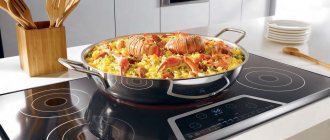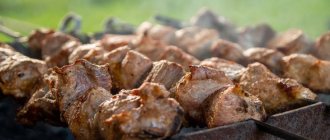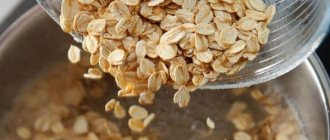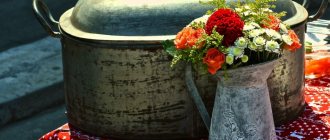Methods for boiling milk
There are several secrets that will help you heat milk so that it does not run away or burn.
1. Proper utensils.
You should not boil milk in it, as it will definitely burn. It is best to use aluminum, glass or stainless steel pans for this. Another way to avoid such trouble is to boil milk in a saucepan with a thick bottom. It allows you to heat the milk more slowly and evenly.
2. Constant stirring
. This method is the most common. You need to constantly stir the milk and remove the foam from it, and then it will not run away or burn.
3. Fat.
Grease the edges of the pan in which you are going to boil the milk with vegetable oil or butter. The fat strip should be approximately 1 cm. The drink will not rise above this strip and will not escape.
4. Sugar
. You can prevent milk from burning by using sugar. It is necessary to add 1 teaspoon of sugar or a piece of refined sugar to 1 liter of drink. In addition, this will keep the milk fresh longer.
5. Cold water.
Before putting the pan on the fire, you need to sprinkle it with very cold water. You can also add some water to the bottom of the pan and boil it, then add the milk.
6. Plate in a saucepan.
Before pouring the milk into the pan, place a small saucer on the bottom, bottom up. As the liquid boils, it will hit the sides of the pan, preventing the formation of foam, which is the main reason that milk runs off and burns.
Why does milk run away?
Another problem that every housewife faces is that milk foams a lot when boiling and runs away, flooding the stove. If you understand why this happens, you can prevent trouble.
When a liquid boils, gas bubbles form. They rise from the bottom and burst on the surface. For example, when water boils, it bubbles. Milk contains a lot of fats and proteins, so the bubbles do not burst, and the dense film that forms on the surface causes them to accumulate under it. When heated, the bubbles become larger, they form a thick foam, which finally breaks through the film and rushes out of the pan.
How to save burnt milk?
If you didn’t pay attention, and the milk still got burnt, then you can fix this problem using one method. Immediately pour the burnt milk into another container and cover with a wet towel. This will eliminate the burnt smell.
Raw milk is fraught with many dangers. Therefore, boiling is the best way to protect yourself from them. We hope that our tips will help you simplify this process as much as possible and your milk will never run away or burn again.
In order to increase the shelf life of milk, as well as to protect yourself from various harmful microorganisms that may be present in an unpasteurized product, it must be boiled. However, before boiling milk, you need to find out how to do it correctly. After all, this is quite a responsible procedure, since the milk can burn or run away. To boil milk, it is better to use an aluminum, glass pan or stainless steel utensil. Milk can burn in enamel dishes, so it is not advisable to use them. A pan with a thick or double bottom can also help avoid burning.
Before pouring milk into the container, you must rinse it with cold water. This action will prevent burning. There is another secret that allows you to boil milk without boiling. Take a small saucer and place it upside down at the bottom of the container in which you are going to boil the milk. Pour the milk into the container. When the milk begins to boil, the saucer will tap a little on the bottom of the pan, however, foam should not form on the surface, therefore, the milk will not boil, and therefore will not run away.
How to care for cast iron cookware
To prevent the pan from burning, you must follow some simple rules.
It is advisable to wash dishes immediately after use. Be sure to wipe the utensils with a paper or woven towel, since rust quickly forms on the wet surface of cast iron, which, when heated, forms a persistent deposit that is difficult to remove.
If the food is still burnt, it is necessary to get rid of the soot as soon as possible by any available method. Cast iron lends itself well to cleaning with metal brushes and abrasives, so you don’t have to be afraid to use them.
A clean frying pan should be greased with a thin layer of interior fat or vegetable oil, wiped with a paper napkin and stored in a closed place, otherwise dust may settle on the oily surface. If you do not plan to use the frying pan in the near future, it is better to put it in a plastic bag.
Experts recommend not using a dishwasher to wash cast iron products - this can lead to the formation of rusty stains.
How long to boil milk
You can simply not leave the stove for a minute. Milk should be simmered over low heat for 2-3 minutes after boiling, while constantly stirring it and removing foam. Foam from milk should only be removed during boiling. After the product has cooled, the film should not be removed, since it contains the bulk of the useful substances.
To increase the shelf life of milk, you can add sugar to it when boiling (1 teaspoon per 1 liter of milk). Milk should be stored in an airtight container (milk tends to absorb various foreign odors) in the refrigerator. Pasteurized milk should not be boiled, since this product has already undergone heat treatment (up to 80 degrees for some time) and all pathogenic bacteria in it have died.
First of all, you should clarify what kind of milk
.
If you bought it in a bottle in a store, then you don’t have to boil
.
But if you purchased milk either at the market, or from some imported tank, then, of course, you must boil it. The best option to milk
from burning is
to boil
it in any pan with a thick bottom.
Recommendations from nutritionists on how long to boil milk
, different.
nutritionists
advise boiling milk for at least 10 minutes.
This, in their opinion, is necessary in order to destroy harmful substances and bacteria in milk. However, the vast majority of nutritionists disagree about the “10 minutes”, since during this time the milk will simply “run away”. Therefore, they recommend boiling the milk
over high heat only until it is completely warmed up and boils away. According to experts, even in this short time, all harmful microbes will be completely destroyed.
Often a coating forms along the edges of the pan and on its bottom, so to avoid it, try to rinse the pan with water every time. Boil milk
need to be on high heat.
To prevent the milk
from boiling over, always place a circle at the bottom of the pan (you can purchase this at a hardware store).
But you can do without a mug - just grease the edges of the pan with some kind of fat. And stir the milk
, otherwise a film will form.
If, for example, you are at the dacha and there is no refrigerator, and at the same time you want the milk
not to spoil for several days, boil it in the morning and evening, but do not cover it until it cools down.
Our magazine is about health, so in our regular column “Healthy Eating” we talk about a product in each issue. Today our story is dedicated to such a popular product as milk.
.
How is it useful? What types of milk
?
How can you tell if milk
? The column is led by doctor V.V. Laidinen.
All about milk
Milk
occupies an important place among food products because it is easily digested and well absorbed by the body.
Milk
has high nutritional and biological value, and this is primarily due to the presence of proteins in it.
Milk
proteins contain all the elements necessary for our body, which are needed by both an adult and a child.
Thus, milk protein contains the amino acid methionine, which is necessary for normal liver function. In addition to proteins, milk also contains fat, amino acids, minerals, various vitamins, calcium salts, magnesium, phosphorus, sodium, potassium, iron, and all of them are perfectly absorbed by the body. Milk
contain animal protein, which is not inferior in value to that contained in meat and fish. It is worth noting that some substances necessary for the body exist only in milk.
Milk
and dairy products are the most important sources of calcium, which, together with fluoride, determines the efficiency of absorption of this product.
There are such types of milk
as drinking, baked, sterilized, pasteurized and skim. Let's look briefly at each of these types.
Types
of milk
So-called drinking milk
, as the name implies, is produced so that it can be drunk immediately.
Baked milk
is characterized by the fact that during its production heat treatment is carried out, and the color of the milk and its taste depend on this.
Sterilized milk
is milk heated under pressure to a high temperature.
This is done to ensure that all vitamins are preserved. However, living bacteria, which are also beneficial to the body, are killed during this process. Therefore, the quality of sterilized milk
is still worse than that of pasteurized milk.
When sterilizing, cow's milk is used, as well as fresh skim milk. milk
tastes like boiled or sometimes baked milk.
To ensure that sterilized milk is well preserved, it is poured into special bags in which the product can be stored from 3 days to 6 months. However, an opened package can be stored in the refrigerator for no more than 3 days. This milk
is different in that it is heated to a temperature of 70°C for half an hour, which allows you to preserve all the beneficial microelements.
This milk
can be stored for no more than 36 hours.
Skim milk
is very beneficial for older people and those who are overweight.
Milk
bags can be stored longer than bottles, which must be stored in a dark, cool place.
If you are going to boil milk,
you should remember that after boiling it must be quickly cooled, and it must be stored chilled.
How to find out if
the milk in front of you is real or diluted
the milk in front of you is real
or it is diluted, you need to drop the milk into a glass of water.
If a drop spreads over the surface of the water, then the milk is diluted. If the milk
is undiluted, then a drop of whole
milk
will fall to the bottom of the glass and dissolve there
.
How much milk to drink per day
According to medical nutrition experts, a person should drink 400-500 grams of milk per day,
i.e. approximately two glasses. It is best to use low-fat, sour or unpasteurized.
Who can drink
milk and who can't
Milk
useful for people with diseases such as atherosclerosis, chronic liver and gallbladder diseases, hypertension.
In general, milk
is good for people of all ages.
Although it may cause stomach upset or heartburn in some people. In this case, you can try drinking milk
half and half with tea.
If in this case the milk
“doesn’t work,” then there is the option of trying
lactose-free milk
.
This kind of milk has now begun to appear in stores. In addition, milk
is not recommended for acute intestinal diseases, as well as for exacerbation of chronic diseases that are accompanied by diarrhea.
People who cannot drink milk
or it is contraindicated for them can consume fermented milk products: kefir and yogurt.
Village fresh milk is considered a real storehouse of useful and healing substances. As you know, during heat treatment a huge proportion of beneficial vitamins and elements are destroyed, but even under this condition, many information sources recommend boiling raw milk.
Milk curdled when boiled
If milk curdles when boiled, it is not fresh. Therefore, it is recommended to process the product immediately after purchase. But it’s better to check first: bring 2-3 tablespoons of water to a boil, add a little milk. If it curdles, it is not worth boiling; it is better to use it for making yogurt. A small amount of soda will help prevent stale milk from curdling.
If the milk has not been checked before boiling and has curdled, do not throw it away. It is better to find out what can be prepared in this case.
- Boil the mixture for 2-3 minutes, place on cheesecloth. You will get soft, tasty cottage cheese.
- If you put cottage cheese under a press, you can make homemade cheese.
- The remaining liquid is whey. It makes tender pancakes.
When you have bought a lot of milk, you can save it from souring by preparing condensed milk. For 1 liter you will need 2-2.5 cups of sugar. Boil the mixture over low heat for 3-4 hours, stirring occasionally.
What is boiled milk?
The simplest and most accessible way to disinfect milk is boiling. With this method, the milk is brought to a boil, that is, bubbles begin to appear along the edges and the milk begins to rise rapidly. At this temperature, milk is boiled for 5 to 15 minutes.
. The boiling process must be monitored so that the milk does not escape. Unfortunately, boiling destroys some of the vitamins D, B, C and A, and most of the calcium goes into a state that will be difficult for the body to absorb. In addition, beneficial life-giving milk bacteria die, and milk protein partially crumbles. The longer the boiling process lasts, the less beneficial the milk.
But! Boiling kills almost all harmful bacteria, with the exception of spores. But where do harmful bacteria in milk come from? Bacteria can get into milk from the hands of a sick person who is milking a cow, from a sick animal, if the animal was not looked after properly, dirty dishes were used, they can get in with food, etc. Thus, plague contagens, tuberculosis pathogens, various salmonella, staphylococci, streptococci and E. coli can get into milk. Therefore, if you purchase milk from an unfamiliar grandmother or from a collective farm car, it is better to play it safe.
Another argument that can be made in favor of boiling is the increase in shelf life. As you know, the bactericidal phase of freshly milked milk lasts only two hours, then pathogenic microbes begin to develop in the milk. Therefore, to prevent milk from spoiling, it is better to boil it.
How to boil milk correctly
First of all, it is worth noting that for boiling it is better to use aluminum cookware or a stainless steel or glass pan
. But it is better to refuse an enamel pan, as the milk will definitely burn in it. Many cookware manufacturers offer to purchase special milk cookers that will prevent milk from running away or burning. If you have a saucepan with a thick bottom, then such unpleasant consequences can also be avoided.
Some people make the mistake of removing the formed film only after the milk has cooled. The film should be removed only during the boiling process itself, but not after, since it contains a large number of significant and useful elements.
It is necessary to store boiled milk in the refrigerator, and better in an airtight container, since milk has the habit of instantly absorbing all unpleasant odors.
Boiling milk not only kills germs, but also destroys many beneficial nutrients. Is there a way out? If you buy pasteurized milk in a store, then this question most likely does not confront you. Well, what if you buy milk at the market, from a farmer living next door, or from a grandmother who still has the strength to keep a cow or a goat? Every morning, when you open a bottle of milk, you probably wonder: why do you boil milk, and should you boil it at all? Some do it out of habit, some know that boiling kills germs, and some do it so it can be stored longer. Boiling is an effective way to combat pathogens. Although it does not remove impurities, it does kill most dangerous bacteria and other organisms. But, at the same time, it destroys some nutrients. Milk is a real storehouse of nutrients. It is a rich source of protein, vitamins and minerals. Minerals, especially calcium, vitamins such as A, D, B1, B2, B12 and K are found in milk in large quantities. Temperature affects many of these vital nutrients in milk, robbing you of the benefits they provide. B vitamins are especially vulnerable when boiled. Is there a way to preserve nutrients? Yes, I have. Here are some basic restrictions that must be observed when boiling milk:
- Do not boil milk at very high temperatures for long periods of time.
- Do not leave milk in an open container after boiling.
- After boiling, cool it immediately.
- Do not heat milk several times.
- Don't forget to stir the milk while boiling.
- Do not use a microwave oven to heat milk.
By following these simple rules, you will retain many of the valuable nutrients in your milk. If you want to boil milk, make sure you do it correctly. So, it comes down to walking a tightrope between safety and nutritional value. Unfortunately, to protect yourself from infection with pathogenic bacteria, a more effective method than boiling has not yet been invented. Whether to boil milk or not is up to everyone to decide for themselves. If you want to make some kind of compromise, that will be your choice.
Perhaps the best advice to prevent milk from escaping is to constantly keep an eye on it by adjusting the temperature.
Second tip: before you start cooking, for example, semolina porridge, pour a little water, about 5 mm, onto the bottom of the saucepan, wait until it boils, and then pour in the milk. The product will not burn, you can wash the dishes without much effort.
Third tip: choose the right cookware. Milk should only be boiled in glass, aluminum or steel containers. Enameled dishes are not suitable for boiling - the milk will burn in them. Before boiling, rinse the container with cold water; this simple step will also prevent burning.
What needs to be done to prevent milk from running away
In addition to the tips described, there is another very effective one that will answer the question of how to boil milk correctly. Take a small saucer and place it on its bottom in the pan so that its bottom faces up. Now pour in the milk product and turn on the heat. As the containers heat up, the saucer will begin to knock on the bottom, but foam will not form on the surface, and therefore there will be no bubbling of the product - the milk will not escape.
You can also boil milk in a water bath. This method has two positive aspects, the first is that the milk will not run away, the second is that you can make baked milk in this way, increasing its preparation to an hour.
A simple and effective way to prevent milk from escaping: grease the edges of the container with a piece of butter. The resulting fat film will create a certain boundary beyond which the milk foam will not escape.
Correct operation
In order to use the frying pan without problems for many years, you must also adhere to the operating instructions. Regardless of the material of manufacture, when cooking, you should add a thin layer of oil, instead of which you can also use fat. As soon as the frying food absorbs the existing product, you need to add a new portion, which is also thinly distributed over the surface.
In the case where the roasting pan is made of aluminum or other metal characterized by the presence of pores, apple cider vinegar will come to the rescue. This ingredient is added after the bottom of the pan is oiled and heated. Direct cooking begins when all the vinegar has evaporated. In principle, you can add a small amount of salt to the vegetable oil already distributed in the pan. Excess is removed with paper towels or napkins.
Spatulas, spoons and other cooking tools should not be metal, as they can easily and quickly damage the surface of the frying pan. In this case, the choice should be made in favor of wooden, plastic or silicone objects. Primary calcination is mandatory for pans made of cast iron and aluminum. Moreover, you are allowed to put the dishes in the oven for no more than an hour, and you should remove them from the stove even earlier - after an average of 40 minutes.
Proper cooking technique can also help prevent food from burning
It is important to choose the correct temperature based on the product being processed. For example, for meat, a higher heat is turned on, but vegetables and fish cook perfectly on both medium and quite low
A flame spreader should always be used in cases where the bottom of the frypot has a large diameter. It is better to take cooking utensils that are absolutely clean and coated with a natural non-stick coating (in the case of aluminum and cast iron containers). The steel frying pan is thoroughly heated before cooking begins.
The oil is either poured onto an already heated frying pan or heated together with it. Products subject to heat treatment must first be brought to room temperature naturally. If some of them were rinsed under the tap, they should be blotted first. It is recommended to place the pieces on the bottom in one layer.
Boil or not?
True, this procedure also has its disadvantages. High temperature not only destroys bacteria, but also destroys vitamins and microelements contained in unpasteurized milk, and also changes the structure of milk protein. The longer a product is cooked, the less vitamins remain in it. Nevertheless, even after this procedure, a sufficient amount of useful substances is retained in the milk. But if you don’t boil the milk you buy by hand, there is a risk of contracting some unpleasant disease, such as E. coli or salmonella. So be sure to boil unpasteurized milk!
Why does a cast iron frying pan burn?
Many cooks encounter food burning to the bottom of the pan. Experts explain that the problem is that cast iron has a porous structure. Upon closer inspection, this is visible to the naked eye.
Under the influence of high temperature during frying, the metal expands, the pores in the thickness of the metal become wider and, as a result, food sticks to the pan. If the dishes are not cleaned periodically, they darken and gradually become covered with soot, which cannot be removed with a simple detergent.
To prevent this from happening, a new frying pan must be properly prepared for use - calcined. If the cookware has already been used, it must be washed and cleaned before heating.
Milk from the store
So, a product purchased at the market or from a village grandmother should be boiled. What about milk from a store or hypermarket? This product has already gone through all stages of heat treatment by the time it reaches the store shelf and is completely ready for consumption. If the packaging indicates that it is UHT or baked, there is no need to boil it. The same applies to infant formula - as a rule, they are enriched with vitamins and minerals necessary for the child, which can be destroyed during heat treatment. In some stores you can also see lactose-free sterilized milk. It is suitable for people with lactose intolerance. This product also does not need to be boiled.
Homemade cottage cheese from frozen kefir
And from frozen kefir you will get the most delicate airy curd, reminiscent of cream cheese. It can be mixed with herbs, salted and used to make sandwiches.
1 liter of kefir.
From the specified amount you will get about 200 g of cottage cheese.
Preparation
It is best to take kefir in a bag: the bottle may crack when frozen, and petrified kefir will be difficult to remove from it. If you only have bottled kefir on hand, simply pour it into a plastic bag and tie it very tightly.
Place the bag in the freezer overnight. Kefir should look like a piece of ice. If after 10–12 hours the kefir still does not become hard as a rock, it means it is of poor quality. This product will produce liquid cottage cheese, more reminiscent of sour cream.
Carefully cut the bag, place the contents in a colander and wrap in gauze.
Leave the kefir at room temperature until completely defrosted.
Choosing dishes for boiling
How to boil milk? What kind of container is best to do this in? The bottom of the boiling pan should be thick or even double, this reduces the likelihood of burning. As for the material, it is preferable to take stainless steel dishes. If you don’t have one on the farm, an aluminum, glass or ceramic container will also work. But it is not recommended to use it - milk can easily burn in it, and it will not be easy to wash such a container. By the way, some manufacturers of kitchen appliances produce milk cookers designed exclusively for this procedure.
Grill pan
A grill is a frying pan that has a grooved bottom. Thanks to the uneven surface structure, the meat is fried so that it retains its juiciness, and at the same time has a crispy crust. If such a frying pan is burnt, what should you do? Care depends on the metal:
- If the cookware is made of cast iron or aluminum, then it must be calcined with oil or salt.
- The enamel container is rubbed with oil, fat, lard, but there is no need to heat it.
- Teflon, ceramics and other non-stick coatings must not be heated or cleaned with abrasives. If such a frying pan begins to stick, what should you do in this case? It will not be possible to clean it completely; it is better to replace the dishes.
It is necessary to choose quality cookware. Also, do not forget about the rules for using frying pans. If you use proven cleaning products, you will be able to preserve the appearance of the dishes and also use them for a very long time.
How to boil?
How to boil milk? Rinse the pan with cool water before placing it on the stove, this will prevent the food from burning. If you place a small saucer at the bottom of the dish, the milk will probably not escape: by tapping on the walls and bottom of the container, the saucer will prevent foam from forming on the surface when the liquid begins to boil.
Place the pan on the stove, pour some water into it and wait until it boils. Add a little milk to the boiling water, and if it does not curdle, pour in the rest. Stirring occasionally, bring the product to a boil over medium heat, and then reduce it. After one or two minutes, the pan can be removed from the stove.
During boiling, milk can escape due to the foam that forms on its surface and prevents the rising air bubbles from bursting. You can remove it only during the boiling process, but not after. It is better to leave the film on the cooled product, since it contains most of the useful substances.
Milk boiler – special double pan
When cooking on the stove in a saucepan, porridge may burn even with constant stirring, and milk may boil over or rise and spill outside the pan.
A milk cooker is a cylindrical pan with double walls and a bottom. A special type of pan allows you to quickly cook dishes without stirring, preserving all the nutrients in the food.
Device and principle of preparation
The operating principle of a milk cooker is to create a water bath effect. The cooking temperature does not rise above +98°C, as a result of which the contents of the pan do not boil, but slowly simmer until cooked. Thanks to the double casing, food burning is completely eliminated. Milk does not escape from the device, and cereals do not burn.
How to use the milk maker:
- The special free space between the walls and the bottom is filled with water. To do this, remove the whistle plug, fill in the liquid, tilt the container at 45°C to drain the excess.
- The hole is closed with a stopper. In many models, the lid is equipped with a whistle that notifies you when it is boiling and ready.
- Pour cereal inside, pour in milk or water, and place on the stove. When the liquid boils between the walls, the inner bowl begins to warm up.
- After the whistle sounds, the heating is reduced. The porridge cooks slowly, does not boil and does not leak from under the lid. Cooking time depends on the grain and volume. On average, porridge is cooked for 5 to 25 minutes. Some types of dishes (oatmeal and rice porridge) are ready when the stove is turned off.
- During long cooking, in order to avoid evaporation of the liquid between the walls, water is periodically added.
What to look for when choosing
To choose a convenient pan that will make the cooking process quick and simple, you need to familiarize yourself with the characteristics and parameters of the product:
- Volume. Dishes with a volume of 1.5 to 2 liters and a height of 13-15 cm are produced; models with a capacity of 3-4 liters are rarely found.
- Wall thickness. The larger the walls, the faster the food cooks.
- Availability of a cover. Pots without lids are designed for melting food or boiling milk.
- Handle on the body. Pots with handles made of heat-resistant plastic or bakelite do not crack or scratch, and can be handled without using oven mitts. Metal handles are durable, do not deteriorate from exposure to fire, but quickly get dirty.
- Material. Mostly pans are made of stainless steel. A cheap option is made of aluminum.
- Measurement scale. A number of marks in grams and milliliters makes preparation easier, since there is no need to use additional equipment.
- Dishwasher safe. Recommendations for caring for cookware are indicated in the instructions.
Review of popular products
Most often, the pan is produced in the form of a large mug, a tall ladle or a milk jug. The most popular milk makers are:
- Gipfel. Stainless steel milk pan with high-gloss polish. The container is equipped with a double bottom and a convenient removable handle. The housing can be washed in the dishwasher.
- Mayer&Boch. The Arian 1.15 liter milk ladle is equipped with a long handle and without a lid. Children's menu dishes, milk sauces and dressings are prepared in the ladle.
- Silampos Nautilus. Milk porridge cooker with a capacity of 1.9 liters with a lid and a multi-layer aluminum bottom. The body is without non-stick coating, the device does not have a heating indicator, and the handles are non-removable. The design includes a spout for draining liquid.
- Tescoma Presto. 2 liter ladle for slow boiling and light simmering of food. The container is equipped with a whistle, a glass lid with a steam hole and 1 long bakelite handle.
- Dosh-Home. Double-walled TAURUS ladle (0.8 l) with heat-resistant glass lid. The bottom is encapsulated with a thickness of 1.8 mm, walls - 0.6 mm. The pan is equipped with a steam vent and the handle is non-removable.
- Metrot. The universal milk cooker “Peaches” has a three-layer enamel coating that protects products from contact with metal. The 2 liter capacity ensures fast and even heating of food. You can heat milk in a saucepan and prepare porridge and cereal puddings without hassle.
What can you cook in a milk cooker?
The pan is versatile and can be used for cooking various dressings, sauces and cereals. You can brew herbal infusions and teas in it, prepare compotes from berries and dried fruits. Due to the steam bath effect in the body, it is easy to melt chocolate, butter or thickened honey. The taste of vegetable sautes and fruit purees is well preserved in the container.
The pan is suitable for brewing creams, glazes, making puddings and soufflés. Using a milk cooker you can make a delicious dessert or fondue. The walls retain the heat of food for a long time, so the container can be used as a thermos for hot drinks (coffee, tea). A milk cooker speeds up the simmering process, so you can make baked milk, yogurt, homemade cheese or kefir cottage cheese in it. Dietary dishes require special temperature conditions; you can also heat baby puree in a milk cooker.
How long to boil?
How long does it take to boil milk? Nutritionists disagree on how long to simmer it. Some doctors recommend doing this for ten minutes or even longer to ensure that all harmful microorganisms are destroyed. But many nutritionists advise boiling milk until it begins to boil away.
So how long should you boil milk? It is believed that harmful microorganisms will be neutralized even in a short time. In addition, the shorter the duration of heat treatment of milk, the more nutrients it will retain.
Heating a frying pan: 3 ways
A cast iron vessel must be treated with detergent, rinsed, and dried. After this, an oil layer is applied. It is better to coat the frying pan with a silicone brush so that the micropores are well filled. For firing, the dishes are placed in a hot oven. At temperatures up to 180 degrees, keep it in the closet for up to 30 minutes. Once the old frying pan has cooled, you can use it again.
Heating a cast iron frying pan with salt.
Treatment is carried out at the first signs of burning. For the procedure, coarse salt is used; it is more convenient to work with. A clean vessel is placed on the fire to evaporate the moisture. Sprinkle salt onto a dry, hot surface in a thick layer and heat it up, stirring occasionally. The appearance of an odor indicates that adhered food particles are burning out. After the salt turns yellow, the procedure is completed. The vessel is rinsed and wiped dry.
The surface is perfectly restored by oil firing. The cast iron is preheated. Pour the oil into a layer of at least 5 mm and leave on the fire for up to 30 minutes. If there is a lot of smoke, the fire can be extinguished earlier. Wipe the pan dry with a cloth or paper towels.
Heating a cast iron frying pan with oil.
This method of cleaning the surface of kitchen utensils allows you to rid them of unpleasant odors. After this treatment, food stops burning and sticking to the cast iron product.
A cast iron frying pan burns - what to do in this case? Firing on the stove or in the oven is done after cleaning the inside of the pot. If there is burnt food on its walls, wash the frying pan several times under running water.
There is no particular difference between firing on the stove or in the oven. It all depends on the degree of contamination of kitchen utensils. In the oven, firing is carried out in a more delicate way than over direct fire. For this treatment, soda is usually used, which is boiled in water for 5 minutes.
Dry firing of cast iron products is possible. It is produced after purchasing a new frying pan. Calcination lasts at least 10 minutes, after which the dishes can be used.
Burning with salt
A simple firing method is carried out in stages.
- Choice of salt. Coarsely ground substances are not suitable for tempering a frying pan. The use of fine salt in this case is encouraged. Its layer should completely cover the bottom of the cast iron cookware.
- Calcination. The process will take about an hour if you keep the pan on low heat. The salt should be stirred periodically for greater effect of heat treatment of the walls of the dishes.
- Trituration. After the kitchen utensils have completely cooled, they need to be further processed. The calcined salt must be thoroughly rubbed over the entire inside of the pan. To do this you will need a soft cloth or napkin.
For the procedure, coarse salt is used; it is more convenient to work with.
After burning with salt, utensils cannot be washed for two days. After the term is announced, the pan is rinsed in cold water.
Oil Quenching
There are several methods of such processing that will help prevent food from burning. The most effective of them looks like this.
- Rubbing with fat. It is better to use a piece of lard or vegetable oil. This remedy will help if you then place the pan in the oven.
- Heat treatment. Place cast iron cookware on a wire rack or baking sheet. Quenching with oil should last no more than an hour at a temperature of 100 – 150 ºC.
- Cleansing. The oil should be removed after processing. In this case, it is best to wipe the walls of the kitchen utensils with a napkin.
- Cooling down. After heat treatment, the pan should be placed in a cool place. You cannot wash it for three days after hardening with oil.
The surface is perfectly restored by oil firing.
Can you boil it in the microwave?
Doctors note that milk can also be boiled in a microwave oven. True, after this procedure there will be even less vitamins and minerals left in it than after boiling on the stove.
How to boil milk in the microwave? It is impossible to give an exact recipe for heat treatment of this product in a microwave oven - the duration depends on both the volume of liquid and the power of the unit. In addition, when using a microwave oven, it is difficult to notice the moment when the milk begins to overflow, so we recommend pouring it into a glass or other deep container.
- To prevent boiled milk from spoiling for a long time, add a teaspoon of sugar for each liter of product while it is boiling.
- If desired, the saucer will be replaced by a special circle or “guard” - these devices can be bought at any hardware store.
- Neither a circle nor a saucer will be needed if you grease the walls of the pan with oil slightly above the level of the milk - this way it won’t run away either.
- A pinch of soda will prevent stale milk from curdling if you need to boil it.
- If the milk is still burnt, pour it into another bowl, adding half a teaspoon of salt for every 2 liters of product, and lower the bowl into a large container filled with cold water (for example, a basin). It is best not to give the burnt liquid to small children, but you can add it to baked goods.
- If you are not going to drink the milk immediately after boiling, pour it into a tightly sealed container so that it does not absorb the odors of other foods, and put it in the refrigerator.
- The plaque that forms after boiling milk must be thoroughly washed off. It’s better to have a separate container that you will use only for this procedure.
- If it is not possible to store sterilized milk in the cold, boil it twice a day (morning and evening) and cover it with a lid only after it has completely cooled. This way the product will keep for two to three days.
Now you know how to boil milk. We hope this information will be useful to you.
05 Dec 2014
I didn’t know where to create this topic. If anything, move it to the right place)))) We’ve been buying homemade milk from the same people for seven years now. Everything was always fine before. For the last three weeks, milk has been burning badly when boiled. We haven’t tried anything .And the pans were changed, sugar was poured in and water was poured in. But it still burns and, naturally, the taste spoils. The last time they took a ceramic cauldron and boiled it in it. We were so glad that it boiled well and there was no smell, but after it cooled we were stunned. We poured it into a bottle and at the bottom of the cauldron there was a layer of 4 millimeters of burnt milk. What could it be?
I am very worried that they simply started adding something to the milk. But I take it for children. Yogurt, porridge - everything is only homemade. We talked with the neighbors and they say the same problem.
Tomorrow these people will come again to sell milk. I want to come up to talk, but I need to stock up on information)) To be smart if anything)))) Photo from the Internet. But this is how it always turns out now. Post edited by supermom: 05 December 2014 - 11:56
It seems to me that if you are in doubt, it is better to refuse. Health is more valuable. My milk doesn’t burn because I have a special aluminum pan with a double bottom)))) But I noticed that different milks leave more or less grains of some grains at the bottom, like semolina.
I also took homemade milk until I put it on sour milk, and it stood fermented with sour cream for a couple of days, warm and not sour.
Before this, yogurt always turned out fine. I began to suspect the addition of antibiotics. And I discovered that this could happen if the cow is not fed correctly, i.e. excess protein feed. And everything would be fine, but such milk is VERY HARMFUL for humans (a lot of ketone bodies accumulate in it). I stopped taking homemade milk and switched to store-bought milk. Of course, there is no guarantee there either, maybe they buy from the same private owners in villages. But I would like to believe that at the production site they carry out at least some kind of control and monitor quality. I take Saki milk, it seems to me that it smells like the milk that we were given at school after the 1st lesson)))) The message has been edited by tutsi: December 06, 2014 - 01:43
No metal jaws
Wire or too hard sponges will enlarge the pores in the aluminum and scratch the bottom of the nonstick coating, wearing out both the inside and outside of the pan. It is worth abandoning such devices and finding a rational alternative. If the food is difficult to clean, then use special brushes whose bristles are of medium hardness, but are safe on the surface.
Forget also about detergents with abrasive particles that can scratch the surface and damage the coating as a whole. It is better to use traditional methods or spend more effort on cleansing with a brush.
How does a cooking pot work? Why?
The cooker consists of two containers, between which there is an air space. The kit includes a lid with a heat-protective handle. There is a whistle on the body that notifies you when the porridge begins to boil. The body also has a handle, made of heat-resistant plastic or metal with silicone protection against burning your hands.
Interesting materials:
How many grams are in one teaspoon of honey? How many faces does a 5-angled truncated pyramid have? How many cores are there in a laptop? How long does it take for a swallow to travel from Smolensk to Moscow? How long does it take for a 1st class parcel from Novosibirsk to Moscow? How long does it take for parcels from Poland? How many imams were there before Shamil? How many Indians are left in the world? How many innings are there in Korean baseball? How many isotopes of uranium?
